Roll up your sleeves! This essay is heavy on visuals and short on words. We are going to show the testing behind four fundamentally different bilingual articulation evaluations that we wrote up without using standardized scores. We have lots and lots of case studies showing how to rule out second language influence. Here we are going to take a look at a Spanish speaker, a French speaker, a Mandarin speaker, and a Dari speaker, which I thought was pronounced dairy when I first saw it (Evidently, I was wrong on that ?).
English-speaking, bilingual, or monolingual SLP; really, we’re all in the same boat. When we’re talking about the number of languages that we have to know in order to evaluate, none of us are bilingual enough. We don’t need to speak every language though. We just need a process to easily evaluate any language we come in contact with.

Spanish – English Bilingual Articulation Evaluation
Let’s get started with our first case which is a Spanish-English speaker. We’re going to begin with one where we have standardized results but will then show them as non-standardized results. That will hopefully give you the confidence that the process that we are doing when we are using non-standardized measures is still extremely valid.
This child was 6;4 years old, his home language is Spanish, school languages are both English and Spanish. We used the Bilingual Articulation Phonology Assessment (BAPA).
The concerns related to articulation were that he was hard to understand. Looking at his BAPA data, we see that there are some errors in red but everything else was produced correctly (green).
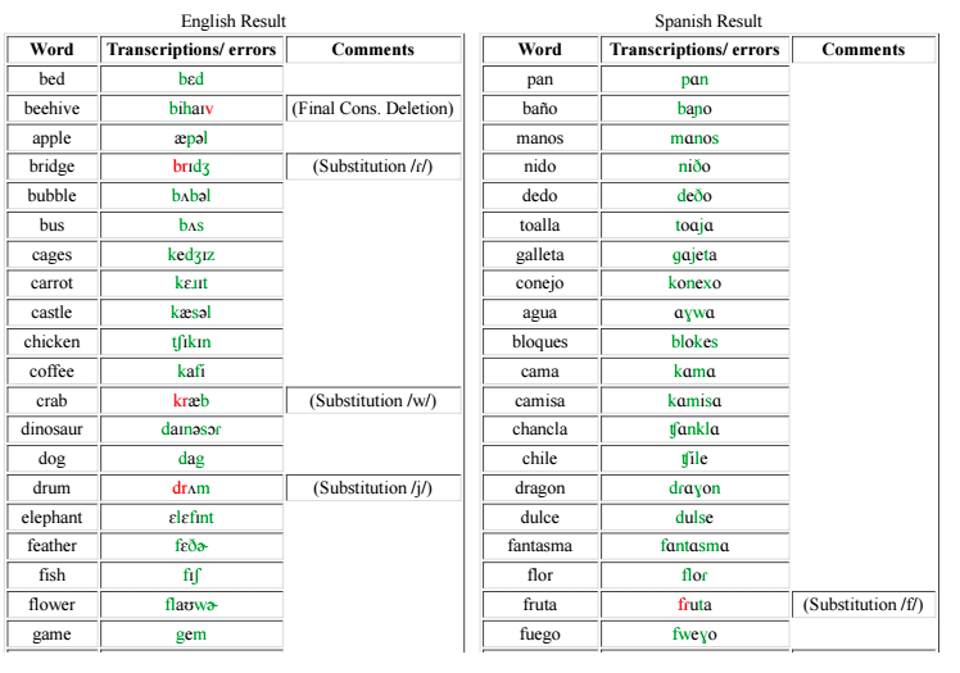
The first thing that I want you to note is that all but one of the errors were on the English side. We have a final consonant deletion, substitution of the flap /r//w/, and /j/ for the English /r/ cluster. So even if he was a native speaker of English, that would fall in the okay range for his age.
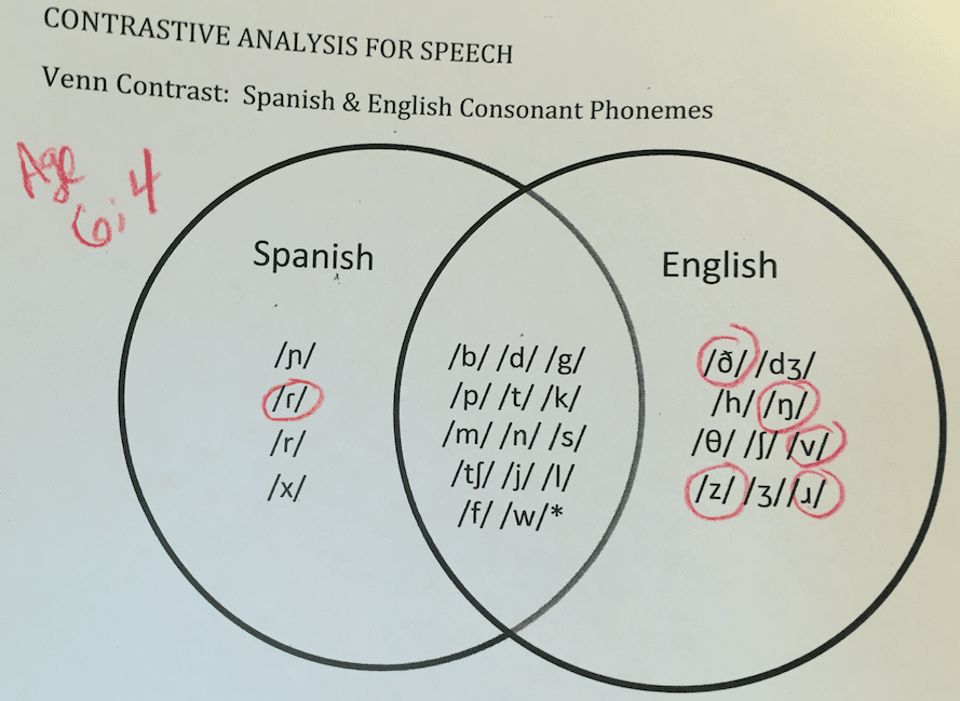
Looking at this Spanish-English Venn diagram, we see that everything is on the English side except the /r/ error from the cluster, which is just fine for his age.
The Result? Spanish-influenced English patterns, but not an impairment.

Dari – English Bilingual Articulation Evaluation
All right, here is our next one. This is an eight-year-old boy in second grade whose family moved to the United States from Afghanistan. His family reported that Dari is the primary language spoken at home. Not only is he new to the U.S., but the family first moved to Houston, Texas and then moved to Austin. So not only a new language and country but a new city, school, and friends for a second time. A lot going on and less than two years of consistent English exposure.
His reading level was 1.4, – fourth month of first grade and math level was 2.0, or the beginning of second grade. Not terribly far behind and his teacher rated his English social communication skills to be average while his academic communication skills were estimated to be below average.
This is a really important thing for us to think about. We know that children acquire their interpersonal communication skills much earlier than they do their cognitive academic language proficiency. So this right here is a very telling statement. We have a student who has quickly learned to communicate socially in English, but is still struggling academically a year and a half into his English learning.
His teacher expressed concerns about his intelligibility. She found that he was difficult to understand while parent did not indicate any concerns about his communication. That’s another important clue. Not everyone involved has the same opinion.
So let’s take a look at a short clip. For his bilingual articulation evaluation we used the Test of Articulation and Phonology (iTap). It is normed on English speakers so we are not using the norms and are just using it for qualitative information. We hear a little difficulty with the English R but most of it is fine.
Now, let’s take a look at his Dari – English Venn diagram. You can see that there are six sounds in English that do not exist in Dari. At the same time, there are six Dari sounds that do not exist in English. When we map out any errors that he made, here’s what we have.
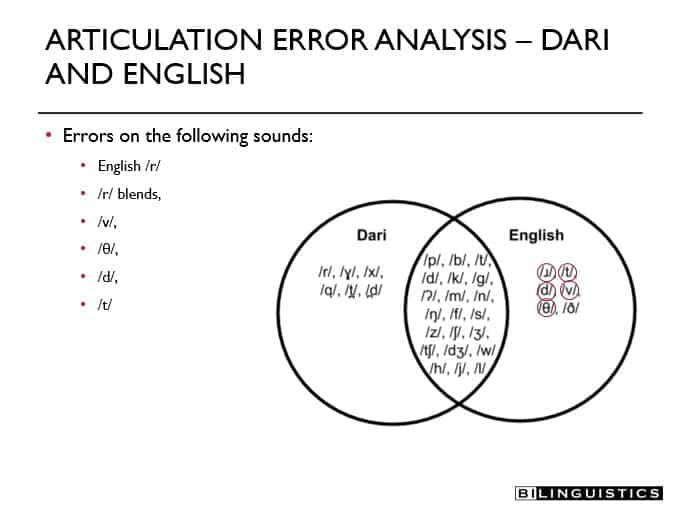
He demonstrated errors on the English /r/, on /r/ blends, on the V, the unvoiced TH, the D, and the T. You can see that these all fall on that English side. His dad came in and interpreted during a story-telling exercise and said that all the sounds sounded okay in Dari.
The Result? Dari-influenced English patterns, but not an impairment.

French – English Bilingual Articulation Evaluation
Next up, we have a French speaker. It’s the language that they use in the home and his parents and his mom reported that he recently shifted to wanting to use English more and was responding to her in English. He had been enrolled in an English program since pre-K so he had about two years of English exposure.
His teacher expressed concerns about his ability to comprehend classroom instructions and word meanings. She also reported concerns regarding expressive language and articulation skills but we’re focused on the articulation for this piece. His mother reported that she has difficulty understanding him at times, and that his pronunciation of words in both languages is off. Here is what the evaluation looked like:
My approach to this was that I went to the Charles Sturt University page that has a number of assessment tools for different languages and articulation. I found a great one for French that has pictures and words and sentences. I printed it in color. I invited his mother to join us for the evaluation. While she was reading these sentences and asking him to repeat words, I was noting her pronunciation of the word, and then his pronunciation of the word and the errors that he was making. So I was able to get a good sense of what his patterns were after a number of productions.
Here’s what I found:
French Articulation Error Analysis
- [l] for [r]
- [z] for [ʒ]
- Weak syllable deletion (occurred frequently)
- Backing (only occurred one time)
- Stopping (occurred two times on the [ʒ] sound, which is a later developing sound.
- Final consonant deletion (occurred frequently)
- Consonant cluster reduction (occurred frequently)
English Articulation Error Analysis
- t͡ʃ for d͡ʒ (French-influenced English)
- d for d͡ʒ (French-influenced English)
- s for t͡ʃ (French-influenced English)
- t for t͡ʃ (French-influenced English)
- d for ð (French-influenced English)
- f for θ (French-influenced English)
- w for r (developmentally appropriate)
- s for ʃ atypical error
- CCR (occurred frequently) atypical error
- WSD (occurred frequently) atypical error
- Final Consonant Deletion (occurred 20% of the time) atypical error
The Results? His use of phonological processes of final consonant deletion, consonant cluster reduction, and weak syllable deletion occur in both French and English. Therefore, these are appropriate intervention targets.

Mandarin – English Bilingual Articulation Evaluation
Moving on to our last one, we are going to look at a bilingual articulation evaluation with a Mandarin-speaking interpreter. I received a referral for a 5;6-year-old girl whose teacher said that she was hard to understand and whose parents said that she had a hard time expressing her ideas. She spoke Mandarin Chinese at home and her school day was spent speaking English. I used the English portion of the BAPA for qualitative purposes of course because she didn’t match the norming group.
I am going to play the full video here which is about 3 ½ minutes long because I think it shows how to easily interact with an interpreter and how you can get all the information you need to make a confident diagnosis in just a few minutes.
With the use of the data from a standardized test, a Venn diagram and phonotactic information on Chinese from the Difference or Disorder Book, the interpreter was able to clearly share her opinion about the sound productions that were not correct and how she thought the student was doing.
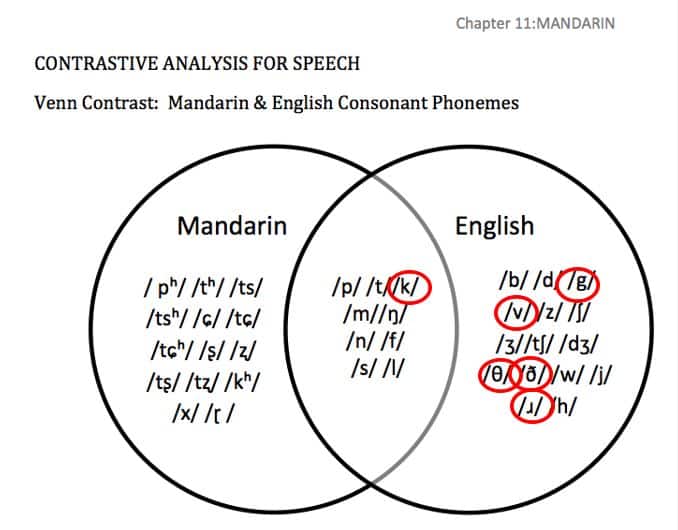

The Result? You guessed it by this point. Mandarin-influenced English patterns, but not an impairment.
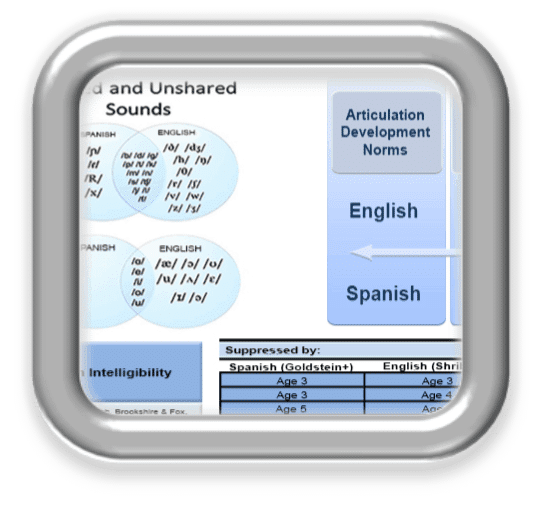
We hope this over-the-shoulder look at bilingual articulation assessments gives you confident that a process does indeed exist and that we are all capable of testing children who speak any language. If you want the full story on this and want to earn CEUs, I talk about it in depth in an online course called Bilingual Language Evaluation Case Study: Step by Step from Referral to Report



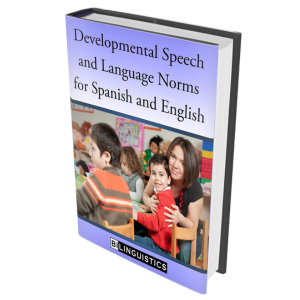
I wish there was more information like this on the Marshallese language. We have a fairly large population in my district and it is so difficult to find much regarding this language and the comparison to English.
Amazing article! Love the case study format. It shows we monolingual SLPs can do this, do it well, and not spend hours and hours to get to the bottom of what’s going on.
Absolutely! We are all monolingual the second a kid with a new language walks through the door. We can all do this – for any language!
Love you guys. It is always a wealth of information when I receive these emails. Would you consider addressing students who are parent denials for bilingual education? We have lots of students in schools who are evaluated and qualify in their native language then 1 year later or less the parent denies bilingual education and they are now in an English classroom. With the requirement to show educational need to the current setting, this can get really “hairy”. Just curious your thoughts.
This is indeed hairy. I think a great way to look at it is that most schools in the nation do not have bilingual services and most of the 400+ languages spoken in our schools are not even supported by an interpreter. In fact, the Spanish/Vietnamese/Mandarin… bilingual programs are the exception to the rule. Parents deny bilingual services for a number of reasons. Here a few I have heard: Their church/parents/friends/WhatsApp group/advocate told them to. They want to distance themselves from their host culture because of struggles they have as adults assimilating. They want their child to speak English/English only. In all cases, parents are making the best decision for their child. If I feel that the child would benefit from bilingual education, I will explain the case, take a recess and let them make a decision. The truth is that bilingual support is nearly unanimously phased out by 3rd grade so it is coming eventually. So… I typically go with whatever the parent wants.
Now, in therapy I can support them by focusing on things that exist in both languages. This means only the speech sounds that both languages share. This means only grammar that both languages share. For example plural /s/ is a great goal for a Spanish speaker, not a good one for a Korean speaker as Korean doesn’t mark the noun for plurals. And, narrative goals are always great because all cultures have stories. If we choose targets that incorporate both languages, we can leave that decision to the general educators and special educators. My two cents.
This is such a helpful review. Thank you Ellen for these case studies as they do serve in helping us help differentiate. More importantly, it empowers us to educate our monolingual colleagues as well.
Totally true Jocelyn. We can all serve bilingual children really really well. We just need to see how it’s done and need a framework to make it repeatable across the multitude of languages we see.